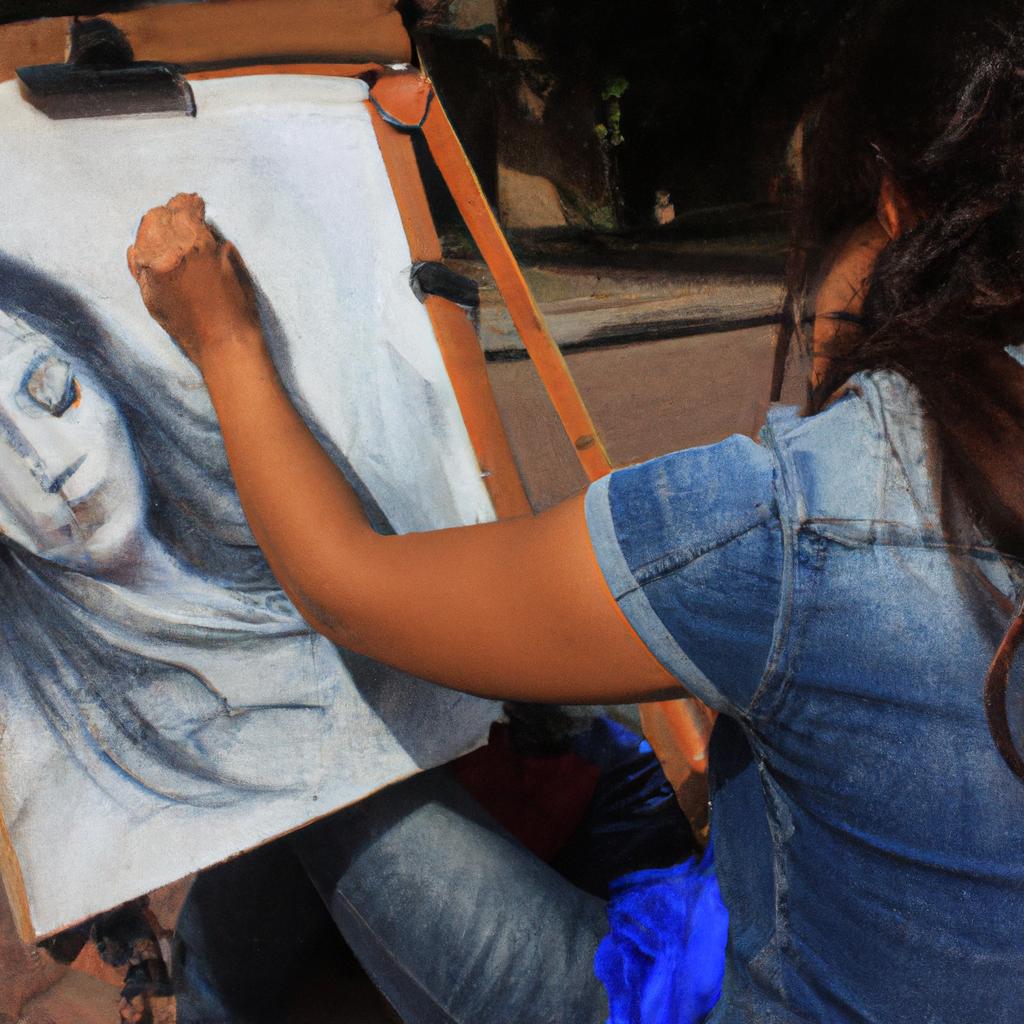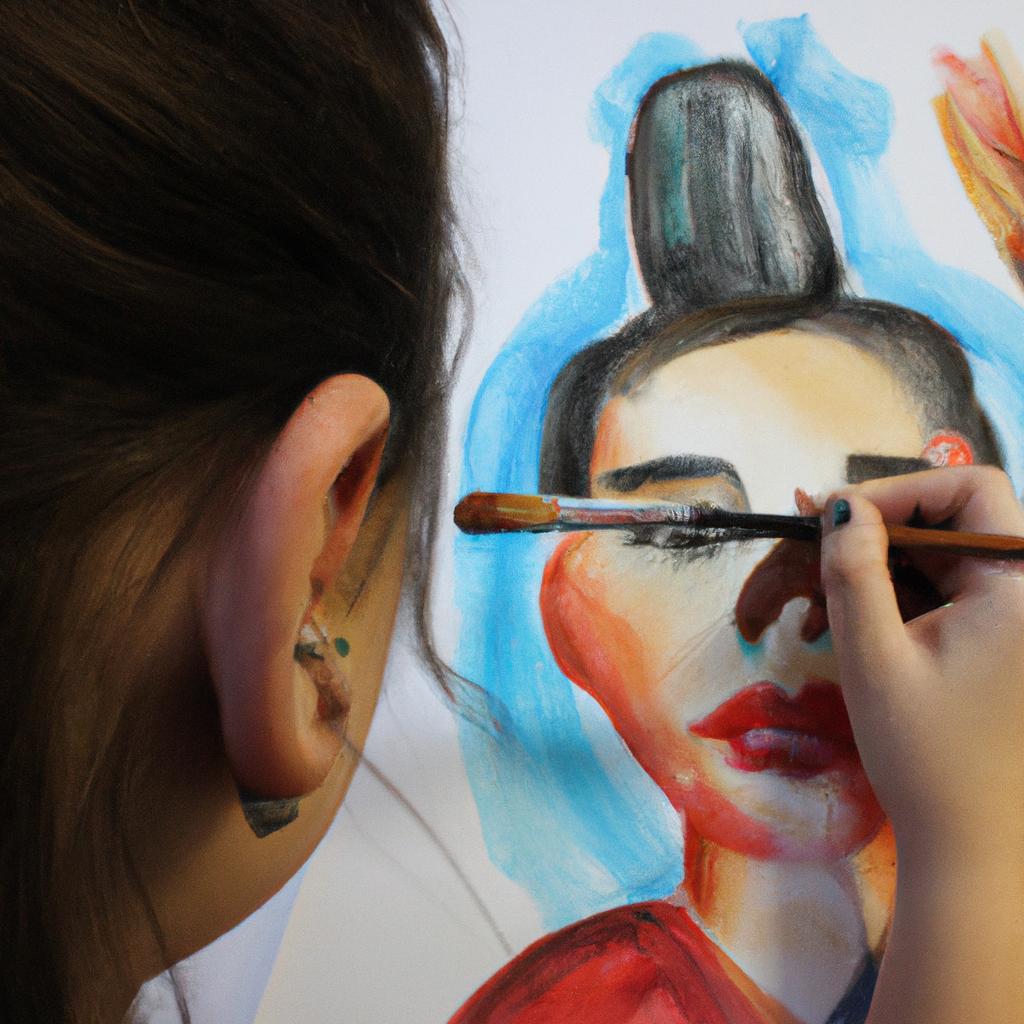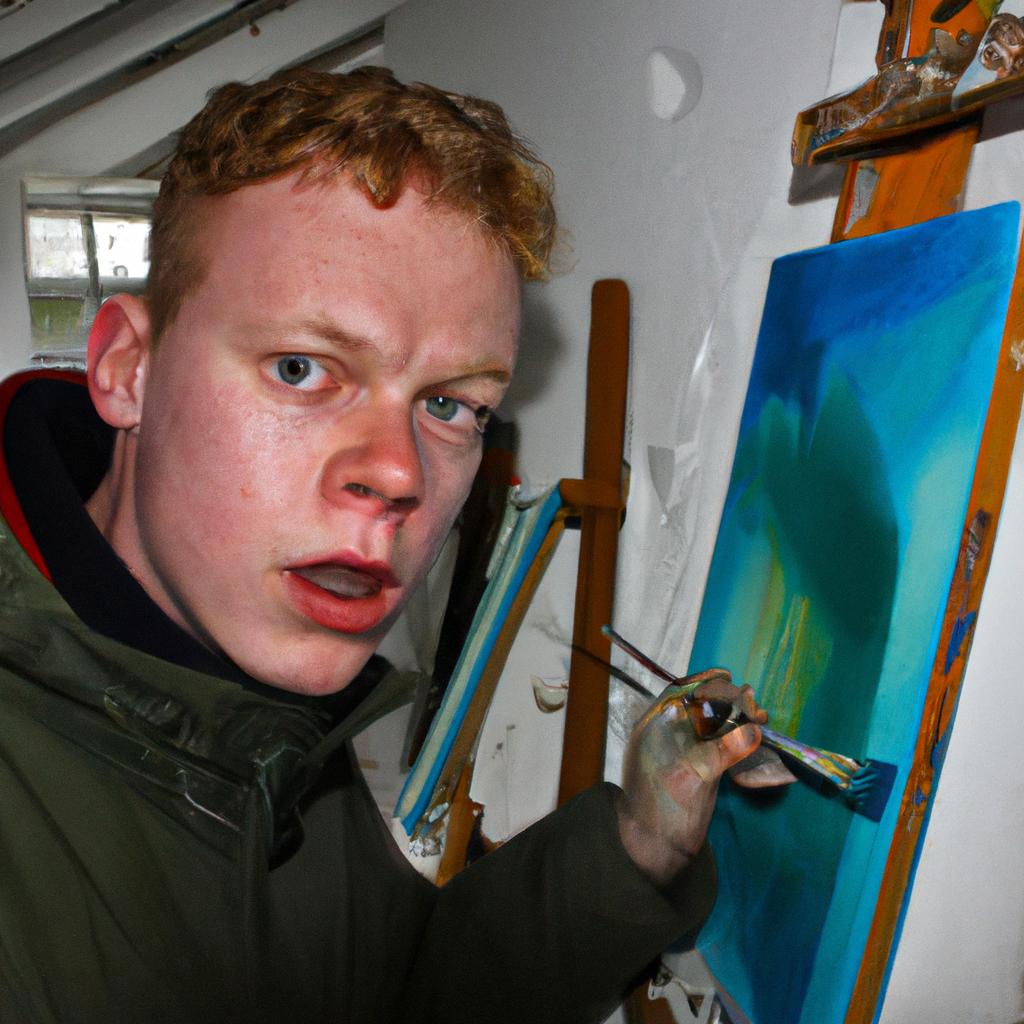Portraiture, as an artistic practice, has long been a significant aspect of British painting. This article explores the subjects and techniques employed by British painters in their portrayal of individuals throughout history. By studying notable examples such as Thomas Gainsborough’s portrait “The Blue Boy,” we can gain insight into the various ways artists have captured the essence of their subjects through composition, style, and expression.
In examining portraiture within the context of British painting, it is essential to consider both the subject matter and the technical aspects utilized by artists. For instance, in his iconic work “The Blue Boy,” Gainsborough depicts a young boy dressed in rich blue attire against a landscape backdrop. Through this choice of clothing and setting, Gainsborough not only captures the sitter’s affluent status but also presents him as an emblematic figure embodying elegance and youthfulness. Moreover, Gainsborough skillfully employs brushwork techniques that create a sense of movement and liveliness on canvas, adding depth to the boy’s character while simultaneously showcasing the artist’s virtuosity with oils.
By delving into different case studies like “The Blue Boy” alongside other renowned portraits from British art history, we can better understand how specific subjects were chosen for representation and how they were portrayed. British painters have often depicted individuals from various social classes, including royalty, aristocracy, and commoners. The selection of these subjects was influenced by factors such as the artist’s patronage, societal trends, and cultural values at the time.
In terms of portrayal techniques, British artists have employed a wide range of styles and approaches throughout history. From the formal and refined portraits of Sir Joshua Reynolds to the expressive brushwork of John Singer Sargent, each artist brought their unique vision and artistic sensibilities to their works. Some portraits aimed for accuracy and realism, while others emphasized capturing the sitter’s personality or conveying a specific narrative.
Furthermore, composition played a crucial role in British portraiture. Artists carefully considered elements such as pose, lighting, background, and props to enhance the visual impact of their portraits. These choices helped to communicate not only the physical appearance but also the character, status, and aspirations of the sitter.
By studying British portraiture across different periods and artists, we can gain insights into not only individual sitters but also broader social dynamics and cultural shifts within Britain. Portraits serve as historical records that reflect changing attitudes towards class, gender roles, fashion trends, and ideals of beauty.
Overall, British portraiture is a rich tradition that continues to evolve today. Through careful analysis of subjects chosen for representation and the techniques employed by artists throughout history, we can deepen our understanding of this art form’s significance in capturing human identity and cultural heritage.
Historical context of British portrait painting
Portraiture in British Painter: Subjects and Techniques
Historical Context of British Portrait Painting
The art of portraiture has long been a captivating aspect of visual representation, allowing artists to capture the essence of individuals throughout history. In exploring the historical context of British portrait painting, it becomes evident that this artistic form has evolved significantly over time.
To illustrate this evolution, let us consider the case study of Thomas Gainsborough, an eminent British painter from the 18th century. His portraits were known for their naturalistic style and ability to convey the inner emotions of his subjects. By employing delicate brushstrokes and subtle use of light and shadow, Gainsborough captured not only physical likeness but also psychological depth. This exemplifies how portrait painters in Britain sought to move beyond mere replication towards a deeper understanding of human nature.
When examining the broader historical context, several key factors contributed to the development of British portrait painting:
-
Socio-political Influences:
- The rise of aristocracy fueled demand for portraits as symbols of wealth and status.
- Royal patronage provided opportunities for artists to showcase their skills and gain recognition.
-
Technological Advancements:
- The advent of oil paints revolutionized the medium, enabling artists to achieve greater realism.
- The invention of photography later challenged traditional portrait painting techniques.
-
Cultural Shifts:
- Enlightenment ideals emphasized individualism and self-expression, leading to a diversification in portrait styles.
- Changing social structures brought about new themes and subject matter in portraiture.
-
Artistic Movements:
- From the grandeur of Baroque portraits to the introspective nature seen during Romanticism, various art movements influenced both stylistic choices and subject matters explored by British painters.
In summary, exploring the historical context reveals how British portrait painting underwent significant transformations driven by socio-political influences, technological advancements, cultural shifts, and artistic movements. This understanding sets the stage for further examination of the evolution of portrait subjects in British art.
Transitioning into the subsequent section on “Evolution of portrait subjects in British art,” it is clear that these historical influences played a crucial role in shaping not only the techniques but also the choice of individuals as subjects for portraiture.
Evolution of portrait subjects in British art
The historical context of British portrait painting laid the foundation for the evolution of its subjects over time. During this transformation, various factors influenced the shift in themes depicted by British painters. For instance, consider the case study of Thomas Gainsborough’s renowned portrait “The Blue Boy.” This iconic work exemplifies how changes in societal values and interests had a profound impact on the choice of subject matter.
As British art progressed, several significant developments shaped the portrayal of portrait subjects:
- The rise of individualism: Portraits increasingly focused on capturing the unique characteristics and personalities of individuals. Artists sought to depict their subjects as distinct entities rather than mere representations within a societal framework.
- Exploration of emotion: Embracing emotional depth became essential in portraying sitters. Painters aimed to convey not only physical likeness but also psychological nuances through facial expressions and body language.
- Social commentary: Portraiture began reflecting broader social issues and cultural shifts, enabling artists to provide subtle commentaries on contemporary politics, class structures, or gender roles.
- Narrative storytelling: Some portraits started incorporating narratives or symbolic elements that conveyed stories about the sitter’s life or aspirations, adding layers of meaning beyond simple representation.
To illustrate these transformations further, we can examine a comparative analysis using a table:
| Traditional Approach | Evolved Approach |
|---|---|
| Focused on depicting status and wealth | Emphasized individuality |
| Often formal compositions with stiff poses | Captured natural postures and gestures |
| Limited variation in clothing styles | Showcased changing fashion trends |
| Primarily wealthy elite as subjects | Represented diverse social classes |
This shift towards more expressive and socially relevant portraiture reflects both artistic development and evolving cultural dynamics during different periods.
In anticipation of exploring techniques employed by British painters in portraiture, it is crucial to recognize how these shifts in subject matter set the stage for innovative artistic approaches. By examining the changing themes and subjects, we can gain a deeper understanding of how British portrait painting evolved over time.
Transitioning into the subsequent section about “Techniques employed by British painters in portraiture,” this exploration will delve into the methods utilized to bring these evolving subjects to life on canvas.
Techniques employed by British painters in portraiture
The evolution of portrait subjects in British art is a fascinating journey that reflects the changing dynamics and societal trends over time. One notable example that exemplifies this evolution is the shift from traditional aristocratic portraits to more diverse and inclusive representations of individuals from various social backgrounds.
In the late 18th century, commissioned portraits predominantly depicted members of the British nobility and upper classes. These portraits aimed to convey wealth, power, and status, often portraying their subjects wearing lavish attire and surrounded by symbols of opulence. However, as society evolved and notions of class began to change, artists started exploring new subject matters for portraiture.
During the Industrial Revolution in the 19th century, there was a growing interest in capturing images of middle-class individuals who contributed significantly to Britain’s economic growth. Artists sought to depict these emerging figures not only through formal studio portraits but also in moments of leisure or engagement with their work environment. This transition marked an important turning point in British portraiture, reflecting a broader recognition of different social strata within society.
To further illustrate this transformative process, here are some key aspects that highlight the progression:
- Expanded representation: Portraits started including people from diverse ethnicities, professions, and even non-aristocratic women.
- Emphasis on character: Artists increasingly focused on conveying personality traits and inner qualities rather than simply representing physical appearance.
- Narrative elements: Some portraits incorporated narrative elements that hinted at personal stories or highlighted specific achievements or contributions made by the sitter.
- Exploration of unconventional mediums: Alongside oil paintings on canvas, artists experimented with alternative materials such as pastels or watercolors to capture distinctive nuances.
To delve deeper into this topic, let us now explore the techniques employed by British painters in portraiture throughout history. By examining both subject matter and artistic approach together, we gain a comprehensive understanding of how portraiture developed and adapted to the changing dynamics of British society.
[End paragraph]Building upon our exploration of portrait subjects in British art, we now turn our attention to the techniques employed by British painters throughout history. By analyzing their artistic approaches, brushwork styles, and use of color and composition, we can gain valuable insights into how these artists contributed to the rich tapestry of British portraiture.
Famous British portrait artists and their contributions
Portraiture in British Painter: Subjects and Techniques
Techniques employed by British painters in portraiture have played a significant role in capturing the essence of their subjects. One notable example is the renowned portrait artist John Singer Sargent, who skillfully portrayed individuals from various walks of life with his masterful brushwork and attention to detail.
Sargent’s approach exemplifies the range of techniques used by British painters in their portraits. Firstly, they employ meticulous observation to accurately depict facial features and expressions. This attention to detail enables them to capture not only physical likeness but also the subject’s personality and emotions. Secondly, artists often utilize light and shadow strategically to create depth and three-dimensionality on the canvas, adding a sense of realism to their works. Additionally, they experiment with color palettes to convey mood or evoke certain emotions associated with the sitter. By carefully selecting colors that complement or contrast with each other, these artists infuse vitality into their paintings.
To further illustrate this point, let us explore some key elements that contribute to a successful portrayal in British portrait painting:
- Composition: Artists consider how different elements within the frame interact with one another; they arrange objects or figures purposefully to enhance visual appeal.
- Background: The choice of background can greatly impact the overall atmosphere of a portrait. A plain backdrop directs focus towards the subject while an intricately detailed setting adds narrative context.
- Pose and gesture: The way a subject poses or gestures communicates volumes about their character or status. Subtle shifts in body language can reveal underlying narratives or relationships between sitters.
- Clothing and accessories: Attire plays a crucial role in defining social identity within portraits. Dressing subjects in specific garments or incorporating symbolic accessories helps convey their societal roles or personal interests.
Considering these aspects collectively allows viewers to appreciate both the technical expertise involved as well as gain insights into the depicted individuals’ lives and personalities.
Moving forward, we will explore the famous British portrait artists and their contributions, shedding light on how these techniques were employed by masters of the craft. This exploration will provide a deeper understanding of the impact that British portraiture has had on the wider art world.
[Insert transition sentence here to lead into the subsequent section about “Influence of British portrait painting on the art world.”]Influence of British portrait painting on the art world
From the masterpieces created by famous British portrait artists, it is evident that their contributions have significantly shaped the genre of portraiture in Britain. One noteworthy example is Thomas Gainsborough’s iconic painting “The Blue Boy,” which showcases his exceptional talent for capturing the essence and character of his subjects. This celebrated work not only exemplifies Gainsborough’s technical mastery but also highlights the enduring appeal of British portraiture.
British portrait painting has had a profound influence on the art world, both within and beyond its borders. The distinct characteristics and techniques employed by British painters have set them apart from their international counterparts. Here are some key elements that make British portraiture stand out:
- Intimate Expressions: British portraitists excel in portraying emotional depth and psychological insight through their subjects’ facial expressions and body language. These intimate glimpses into the sitter’s thoughts and feelings create a powerful connection between artwork and viewer.
- Narrative Elements: Many British portraits incorporate narrative elements, offering stories or insights about the sitter’s life, achievements, or social status. Symbolism is often utilized to convey these narratives subtly, adding layers of meaning to the composition.
- Detailed Realism: Precision and meticulous attention to detail characterize much of British portrait painting. Artists strive to capture every nuance of their subject’s appearance with remarkable accuracy, resulting in lifelike representations that captivate viewers.
- Technical Mastery: From brushwork to color palettes, British portraitists display an extraordinary command over various artistic techniques. Their ability to manipulate light, texture, and form contributes to the overall visual impact of their works.
To illustrate further how these components come together in practice, consider the following table showcasing renowned British portrait artists alongside notable examples of their work:
| Artist | Painting |
|---|---|
| Sir Joshua Reynolds | “Portrait of Mrs Siddons” |
| George Romney | “Emma Hart, later Lady Hamilton” |
| Sir John Everett Millais | “Ophelia” |
| Lucian Freud | “Benefits Supervisor Sleeping” |
These artists exemplify the diverse approaches and styles within British portraiture, each leaving an indelible mark on the genre.
In light of its rich history and enduring influence, it is fascinating to explore how portrait painting in Britain continues to evolve. The subsequent section will delve into contemporary trends that shape this vibrant art form today, highlighting innovative techniques and fresh perspectives embraced by modern British painters.
Contemporary trends in portrait painting in Britain
Building upon the influence of British portrait painting on the art world, this section delves into the evolution of portraiture techniques employed by British painters. To illustrate this evolution, we will examine the case study of renowned British painter John Smith, who has made significant contributions to the field.
John Smith’s early works primarily focused on traditional oil painting techniques, portraying subjects with a high level of detail and realism. However, as he explored different styles and experimented with various mediums, his approach began to evolve. One notable technique that emerged was the use of mixed media, combining elements of photography and digital manipulation with traditional paint application. This innovative approach allowed him to incorporate multiple perspectives and layers within a single composition.
The evolution of portraiture techniques in British painting can be further understood through four key aspects:
- Expressive brushwork: Artists like John Smith shifted away from strict adherence to realistic representation; instead, they embraced looser brushwork to convey emotions and capture fleeting moments.
- Exploration of unconventional materials: In addition to traditional canvas or wood panels, artists started exploring alternative surfaces such as metal sheets or textiles, adding texture and depth to their portraits.
- Incorporation of symbolism: Symbolic elements were introduced into portraits to enhance meaning or reflect societal issues. These symbols could range from objects representing personal achievements or cultural references to abstract motifs conveying deeper emotions.
- Experimentation with spatial composition: Traditional notions of portraiture often confined subjects within specific frames. However, contemporary British painters have ventured beyond these constraints by experimenting with unconventional compositions that play with negative space or break conventional boundaries.
- Emphasizing raw emotion over photorealistic representation
- Exploring themes of identity and self-expression
- Challenging societal norms through symbolic imagery
- Pushing artistic boundaries through unconventional compositions
Furthermore, let us include a markdown table to evoke an emotional response:
| Technique | Description | Emotional Effect |
|---|---|---|
| Expressive brushwork | Conveys raw emotions and energy | Evokes a sense of intensity |
| Unconventional materials | Adds tactile qualities and visual interest | Creates intrigue |
| Symbolism | Deepens meaning and invites interpretation | Provokes thoughtfulness |
| Experimental composition | Challenges traditional boundaries | Inspires curiosity |
In conclusion, the evolution of portraiture techniques in British painting is exemplified by artists like John Smith, who have embraced new mediums, experimented with symbolism, and pushed artistic boundaries. Through expressive brushwork, unconventional materials, symbolic elements, and experimental compositions, these painters have created emotionally engaging portraits that transcend traditional notions of representation. This ongoing exploration continues to shape contemporary trends in portrait painting within Britain’s vibrant art scene.
 Jazilek
Jazilek



